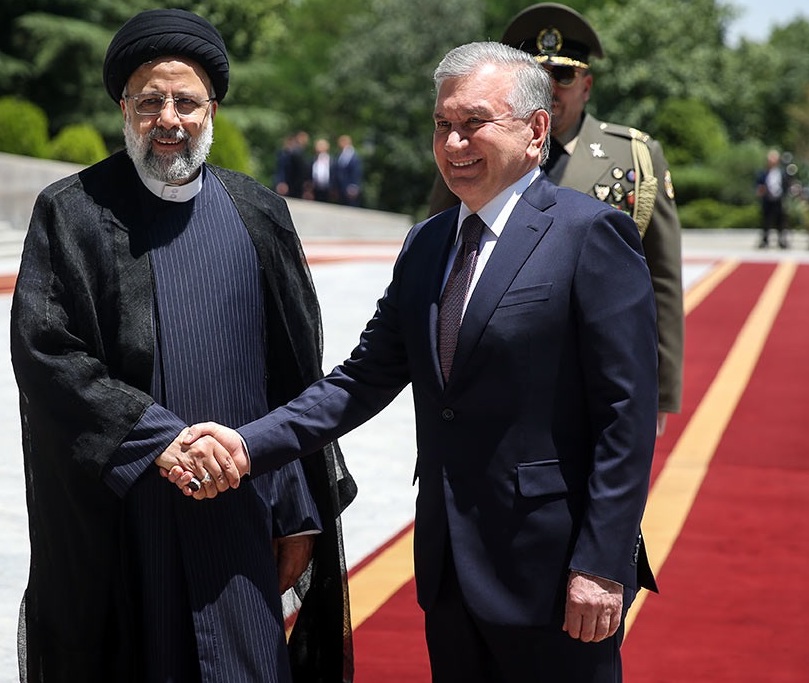Wedged by Russia, China, Iran and Afghanistan, the Central Asian republics are pursuing multi-vector foreign policies to ensure economic growth and navigate among the local powers, as well as the US and Europe, even though the latter have antagonistic relations with the four countries.
The republics know, “When the elephants fight, the grass suffers,” reads an article published in OilPrice.come. Excerpts follow:
Uzbekistan is an example of the political entrepreneurship demanded of the republics, as they press ahead in an environment shaped by the twin shocks of the Taliban victory in Afghanistan and the NATO-Russia war in Ukraine.
In June 2023, Uzbek President Shavkat Mirziyoyev met Iran’s President Ebrahim Raisi and Iran’s Leader Ayatollah Ali Khamenei. The meeting netted cooperation pacts in areas as diverse as agriculture, energy, customs affairs, sports, science, technology and innovation, cultural exchanges, healthcare, Chabahar Port, the environment, industry and tourism. It was the first visit to Iran by an Uzbek leader in over 20 years.
The countries plan to increase annual trade to $3 billion, according to Raisi (trade was $431 million in 2021), and intend to develop a transport corridor through Turkmenistan, which Mirziyoyev first discussed with Turkmenistan’s President Serdar Berdimuhamedow in October 2022. (Transportation cooperation between Tashkent and Ashgabat started in 2017 with the opening of the Turkmenabat-Farab railroad and car bridges that will link the countries and open opportunities for long-distance trade.) Raisi pledged to connect Uzbekistan to high seas via Turkmenistan and Afghanistan.
The June meetings were a follow-up to the March 2023 visit by Uzbekistan’s foreign minister who met Iran’s ministers of foreign affairs and industries. Afterwards, the parties announced efforts to increase trade turnover, and foster business links and people-to-people ties. The ministerial meetings built on the September 2022 visit by Raisi to Uzbekistan that produced 17 agreements in areas such as energy, transport and agriculture, and discussed how to double trade from the current $500 million annually, though in less than a year the trade target has ambitiously increased to $3 billion.
Iran is increasingly attractive to the landlocked Central Asian republics that are seeking new trade routes. In June 2021, Tashkent hosted a conference to highlight Central Asia-South Asia connectivity via Afghanistan and Pakistan.
Two months later, the US and NATO retreated from Afghanistan and the country plunged in chaos, so the republics had to consider alternatives. In February 2022, the Russia-Ukraine war forced Kazakhstan to develop a trans-Caspian route to avoid the effects of the Russian-Ukraine war, and the other republics followed suit.
Central Asia can now consider trading through Iran’s ports of Chabahar and Bandar Abbas.
(In January 2022, Iran and Uzbekistan concluded an agreement to give Uzbekistan access to Chabahar Port in the Sea of Oman.)
Iran can offer a space free of the violence by the Islamic State and the Pakistani Taliban that plagues Afghanistan and Pakistan; organized and functioning government agencies; and ports adjacent to the markets of India (Chabahar) and the Persian Gulf (Bandar Abbas). Iran is also a large market of close to 90 million people.
The US has promoted the Middle Corridor to the republics as an alternative to Iran, but avoiding the “Southern Corridor” via Iran or Afghanistan-Pakistan, deprives the republics of ready access to Asia and the Persian Gulf. The republics are not burdened by Washington’s sense of grievance against Iran that has festered since 1979, especially as there would be an economic cost of joining Washington’s campaign against the Islamic Republic, with no offsetting benefits other than a thank you for “doing the right thing.”
The republics want a reliable partner who can also help them deal with instability in Afghanistan. Iran shares that interest and has no territorial aspirations in Central Asia, though it will seek political support from the republics in fora such as the United Nations, as it implements its “Look East” policy and seeks a larger regional role through groups like the Shanghai Cooperation Organization.
(All the republics, except Turkmenistan, are full members of SCO; Turkmenistan is not a member but attends SCO meetings.)
The people of Tajikistan are Persian-speaking and many historic cities in the region, such as Samarkand and Bukhara in Uzbekistan, and Eastern Uzbekistan, are home to Tajik people who are indigenous to the region, so Iran will use cultural links, old and new, as tools of influence.


